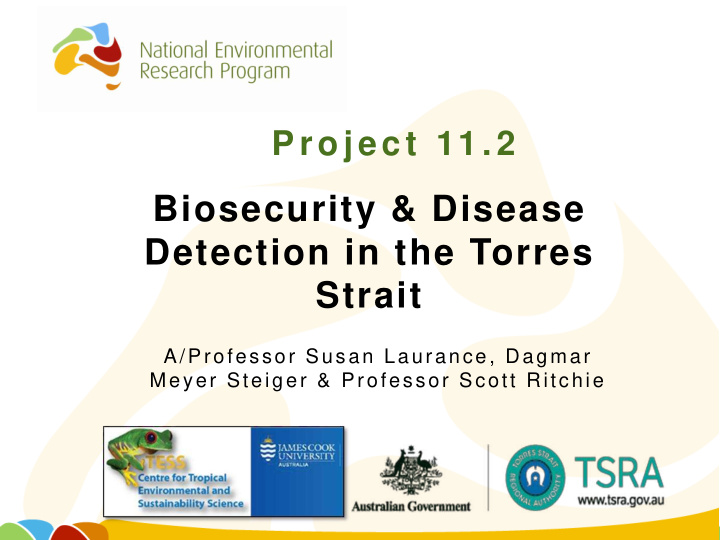



Project 11.2 Biosecurity & Disease Detection in the Torres Strait A/Professor Susan Laurance, Dagmar Meyer Steiger & Professor Scott Ritchie
Emerging Infectious Diseases EBOLA HENDRA EXISTING DISEASE TRANSMITTED TO A NEW HOST CHYTRID AVIAN MALARIA DISEASE MOVED TO A NEW AREA
Understanding Disease Risk • Disease detection is higher in developed world • Disease risk is higher in tropical frontier regions EID Risk EID Detections
Understanding Disease Emergence 1) Human land use 2) Inadequate disease surveillance Novel interactions CO 2 Attractant Power
Papua New Guinea Our research challenge was to work in the Torres Strait – a remote tropical area – and Australia with limited funds
Step 1: Develop & trial novel mosquito sampling methods for remote regions Standard CDC mosquito trap New passive box trap (no power) with CO 2 from yeast & sugar with battery & CO 2 from dry ice
Field trial results Dry ice generates more CO 2 But importantly the same species are caught with yeast attractant (where mosquitoes are abundant RF & Man). Novel method can replace standard sampling for remote areas!
Step 2: Field Study in the Torres Strait A comparison of mosquitoes in villages & native habitat on 4 islands, 2 years X X
Results • ca. 12,000 mosquitoes captured & identified
Where did we capture the medically important mosquitoes? SAIBAI BOIGU BADU MOA Village Bush Village Bush Village Bush Village Bush Aedes aegypti Aedes albopictus Aedes scutellaris Anopheles farauti Culex sitiens group Culex quinquefasciatus Mansonia unformis Verrallina funerea
Research Review Community Fact Sheet
Step 3: A novel method for disease detection in mosquito vectors (& capacity building in North Qld) • Sugar-coated FTA cards installed in traps to collect mosquito saliva
Step 3: A novel method for disease detection in mosquito vectors (& capacity building in North Qld) Attempt to extract viral and parasitic RNA/DNA from FTA Cards for: – avian & human Malaria – Dengue – Ross River fever – Kunjin – Japanese encephalitis – Chikungunya Q. How effective is this method with low disease incidence?
Step 4: Future research • Continue to trial different yeast varieties & trap modifications
Conclusions • Torres Strait is one of the most “at risk” communities in Australia with respect to mosquito- borne EID’s
Policy recommendations to manage EID Risk in Torres Strait • Remove larval habitats in villages – rubbish removal highest priority • Fly-screens & treated bednets • New houses - high-set on hard foundations • PNG visitors need to stay in mosquito-safe environs
THANK YOU
Recommend
More recommend